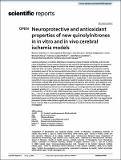Por favor, use este identificador para citar o enlazar a este item:
http://hdl.handle.net/10261/309028COMPARTIR / EXPORTAR:
 SHARE SHARE
 CORE
BASE CORE
BASE
|
|
| Visualizar otros formatos: MARC | Dublin Core | RDF | ORE | MODS | METS | DIDL | DATACITE | |

| Título: | Neuroprotective and antioxidant properties of new quinolylnitrones in in vitro and in vivo cerebral ischemia models |
Autor: | Chamorro, Beatriz; Izquierdo-Bermejo, Sara; Serrano, Julia CSIC ORCID CVN; Hadjipavlou-Litina, Dimitra; Chioua, Mourad CSIC ORCID ; López-Muñoz, Francisco; Marco-Contelles, José CSIC ORCID; Martínez-Murillo, Ricardo CSIC ORCID; Oset-Gasque, María Jesús | Fecha de publicación: | 2023 | Editor: | Nature Publishing Group | Citación: | Scientifc Reports (2023) 13:2865 | Resumen: | Cerebral ischemia is a condition affecting an increasing number of people worldwide, and the main cause of disability. Current research focuses on the search for neuroprotective drugs for its treatment, based on the molecular targets involved in the ischemic cascade. Nitrones are potent antioxidant molecules that can reduce oxidative stress. Here we report the neuroprotective properties and the antioxidant power of the six new quinolylnitrones (QNs) 1–6 for their potential application in stroke therapy. QNs 1–4 are 2-chloro-8-hydroxy-substituted QNs bearing N-t-butyl or N-benzyl substituents at the nitrone motif located at C3, whereas QN5 and QN6 are 8-hydroxy QNs bearing N-t-butyl or N-benzyl substituents at the nitrone motif located at C2, respectively. In vitro neuroprotection studies using QNs 1–6 in an oxygen-glucose-deprivation model of cerebral ischemia, in human neuroblastoma cell cultures, indicate that all QNs have promising neuroprotective, anti-necrotic, anti-apoptotic, and anti-oxidant properties against experimental ischemia–reperfusion in neuronal cultures. QN6 stands out as the most balanced nitrone out of all tested QNs, as it strongly prevents decreased neuronal metabolic activity (EC = 3.97 ± 0.78 μM), as well as necrotic (EC = 3.79 ± 0.83 μM) and apoptotic cell death (EC = 3.99 ± 0.21 μM). QN6 showed high capacity to decrease superoxide production (EC = 3.94 ± 0.76 μM), similar to its parent molecule α-phenyl-tert-butyl nitrone (PBN) and the well-known anti-oxidant molecule N-acetyl-l-cysteine (NAC). Thus, QN6 demonstrated the highest antioxidant power out of the other tested QNs. Finally, in vivo treatment with QN6 in an experimental permanent stroke model elicited a significant reduction (75.21 ± 5.31%) of the volume size of brain lesion. Overall, QN6 is a potential agent for the therapy of cerebral ischemia that should be further investigated. | Versión del editor: | http://dx.doi.org/10.1038/s41598-023-29929-7 | URI: | http://hdl.handle.net/10261/309028 | DOI: | 10.1038/s41598-023-29929-7 | Identificadores: | doi: 10.1038/s41598-023-29929-7 issn: 2045-2322 |
| Aparece en las colecciones: | (IQOG) Artículos (IC) Artículos |
Ficheros en este ítem:
| Fichero | Descripción | Tamaño | Formato | |
|---|---|---|---|---|
| s41598-023-29929-7.pdf | 2,6 MB | Adobe PDF |  Visualizar/Abrir |
CORE Recommender
SCOPUSTM
Citations
1
checked on 17-abr-2024
WEB OF SCIENCETM
Citations
1
checked on 17-feb-2024
Page view(s)
48
checked on 24-abr-2024
Download(s)
15
checked on 24-abr-2024
Google ScholarTM
Check
Altmetric
Altmetric
Este item está licenciado bajo una Licencia Creative Commons

